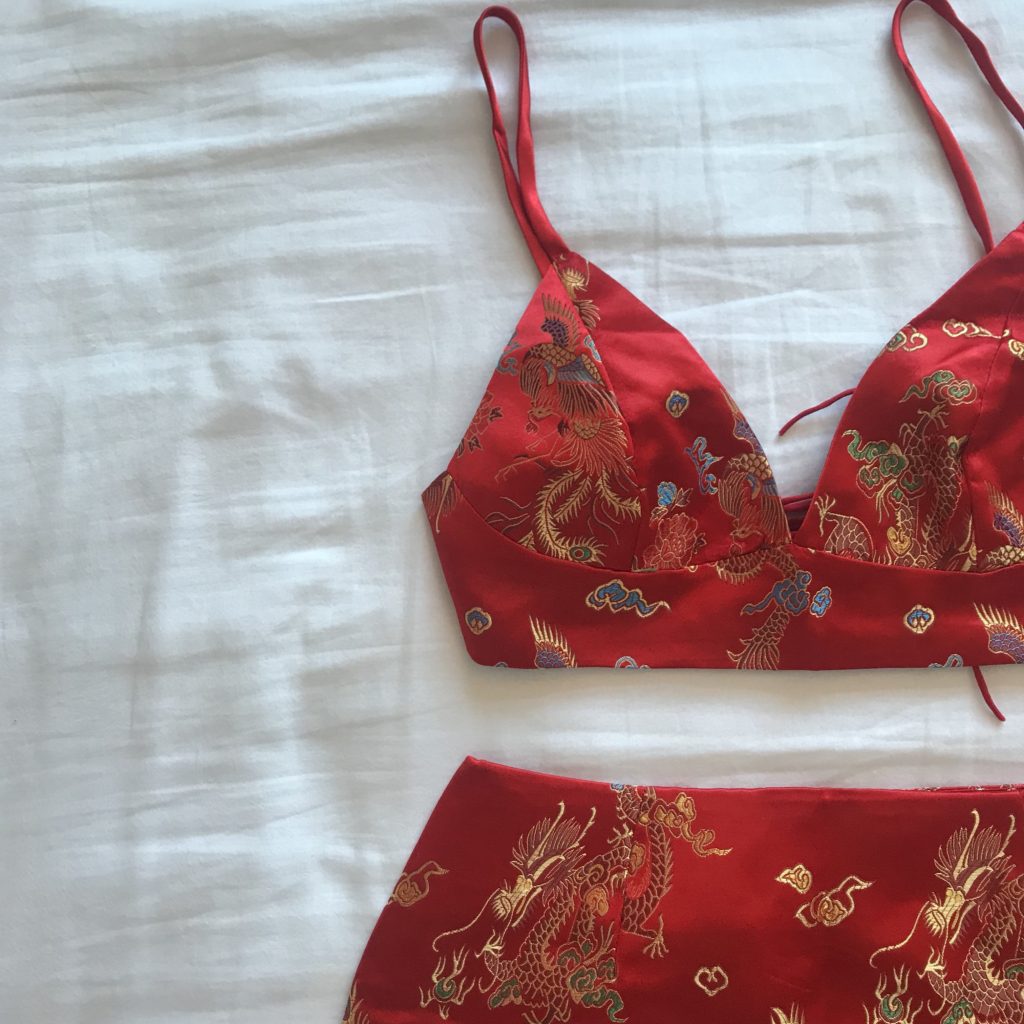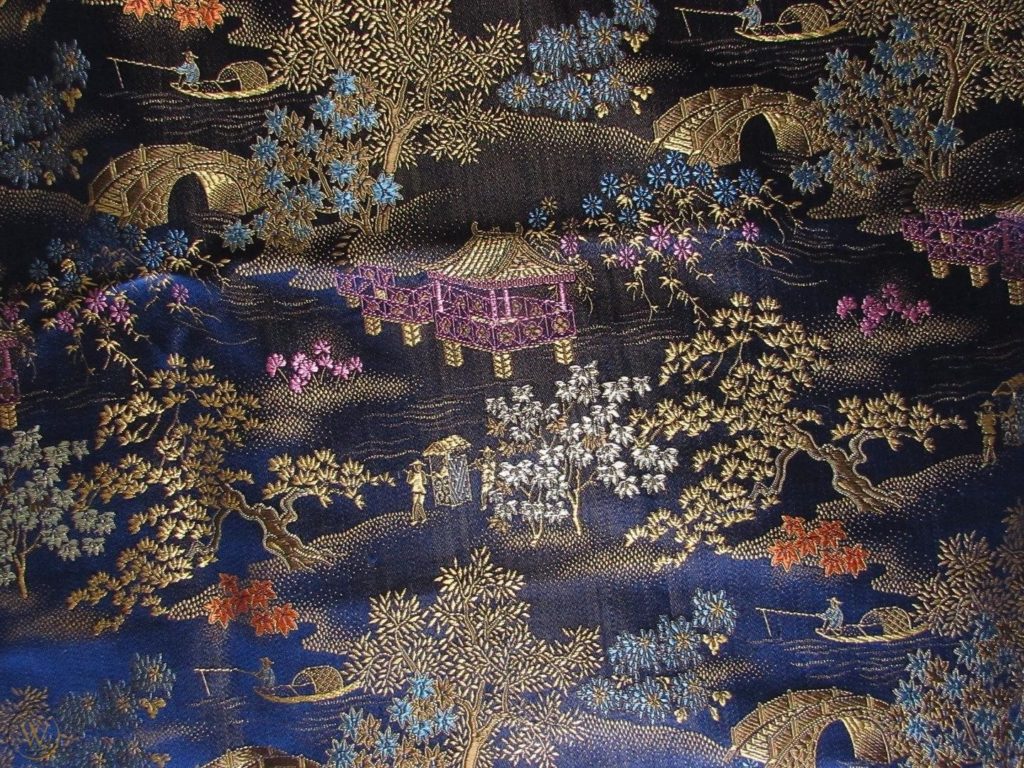A SILKEN REFLECTION

Nancy Duong
31 October 2019
You’d have a hard time scrolling down your Instagram or Twitter feed without seeing this silhouette—a bralette/corset hybrid top and an A-line miniskirt cut from the same cloth. Trendy to the point of oversaturation, you have probably seen it reimagined in every fabric and pattern possible. So, when my friend drops a picture of just that in our group chat, it is familiar in more ways than one: the print of that ubiquitous silk that has become a signifier for Asian dress, transplanted onto a cut and style that floods fast fashion catalogues. “What do y’all think?” she asks, starting that inevitable conversation. “Is this cultural appropriation?”
My first thought was that I didn’t see any singular culture represented in this set. Although silk brocade can be found in variations across the huge continent of Asia, this outfit did not look like any traditional attire that might be found in any one particular country. We puzzled over whether the material held a cultural significance when taken out of context like this, one disjointed part of a whole. Was it now simply disembodied fabric, free to be molded to any pattern?
Yet the associations which that particular silk conjured were too strong to be shaken. Something about it still sat wrong with me—while it was a decidedly Western garment, it managed to widely register as ethnic, specifically as Asian, to the point where it could be marketed as such. The Asianness invoked by the fabric was not one of reality, but Asia as it exists in the Western imagination: shimmering, one-dimensional, objectified, othered. All of it at once, a single foreign entity with a single foreign face, and yet none of it. Maybe that’s the appeal: the fantasy of culture, of an exotic and oriental kind of beauty, without the repercussions.
When dealing with this abstraction of foreignness rather than a tangible culture, the concept of ownership becomes muddy. In that particular case, the person selling these silky two-pieces on Instagram was in fact Chinese. This might be read as the reclamation of an image that has been pushed upon those racialized as Asiatic, materially gaining from what had been alienation. Or perhaps it was a cultural motif reworked and revised for a different, less traditional audience. On the other hand, it could also be construed as actively cosigning a harmful conception of Asianness for a profit.
And without a doubt, sometimes Asian people are the buyers of these fusion outfits, which opens up another onslaught of questions. Is that their right, as someone racialized as Asian? Or are they only making themselves easier to consume to Western eyes by aligning to what they expect to see? Conversely, is it even our responsibility to worry about how we appear to the biased Western gaze? After all, this Orientalist view of Asia did not spring from simple ignorance: it's motivated by a political and economic end and cannot simply be debunked. Should we focus on centering ourselves, existing on our own terms rather than those of the West?
Being Asian American, born and raised in the West and steeped in its ideas and values, I occupy a strange space. Like looking in a mirror, I am both spectacle and voyeur. But the mirror is warped, and I don’t think I’ll ever be able to fully reconcile reality with the reflection. I cannot condemn the Western gaze without indicting myself and the perceptions I’ve internalized, the gaze I turn upon myself and those who look like me. Maybe I am simply drawn to a print or design or idea, and it just happens to signal some part of Asia, real or imaginary. However, I don’t think that will ever be extricable from the ambiguous images of Eastern allure fed to me through the Western lens, the ones that I’ve grown up with and perhaps have even come to identify with, somewhere deep down. I’m not sure if I’ll ever really find an answer for the questions I pose, but for now, maybe asking them is a start. Caught in a web of imperialism and capital, maybe thinking about where exactly I am positioned in it is the first step to freeing myself.
In an era where the illusion of social consciousness can be profitable, performative a
ctivism is rampant. Often, figures in the public are motivated not by a desire to reduce harm and be accountable, but a fear of potentially losing social capital. The result is a public that sometimes can recognize something is not acceptable, shuffled into a shadowy category of offensiveness, without examining why. When topics such as cultural appropriation come up, we often think about them in terms of what is “allowed”, what will minimize backlash. Rather than thinking about the power dynamics at work, our own relationships to power, what cultural biases we might be perpetuating, we often tend to think in terms of technicalities, loopholes, semantics. But to think that evading a definition means you are doing no harm is dangerous. Such a mindset serves to center yourself and the consequences that exclusively affect you. When we think about our place in the world, what we receive and put out into it, we don’t always come to a simple, cut-and-dried answer.
Fashion is art, and thus seeks to express, to make a statement. Ask yourself: what does wearing this say, whether whispered or shouted? What is the persona or the aesthetic that is being curated and what are the implications of that? What is the intention, and how well does that actually line up with the impact? Every article of clothing tells a story, but that story shifts and distorts based on who dons it. Is its narrative one of celebration, of subversion; or of dominance, of erasure, of fetishism? Clothing, at its core, is simply fabric and thread, but it acts as a mouthpiece through which we speak volumes. What we attempt to say with it is what needs to be held up to the mirror.



